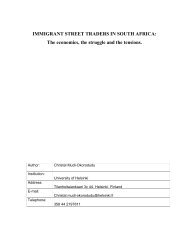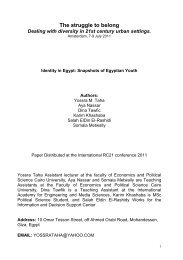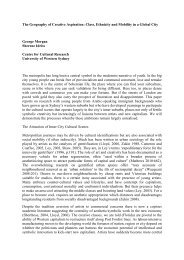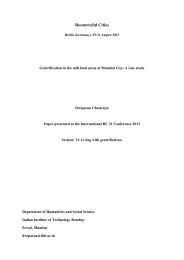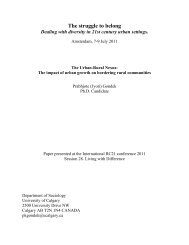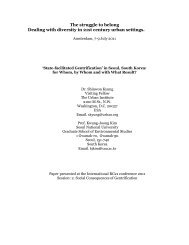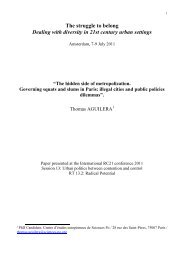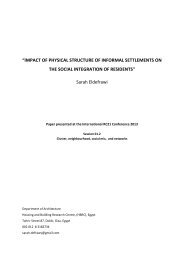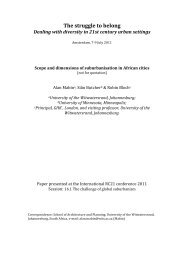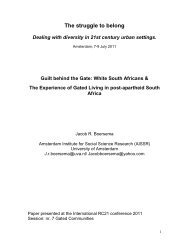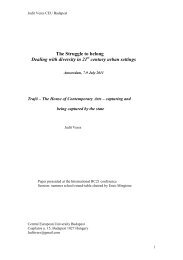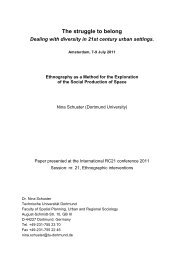Fragmentation as a threat to social cohesion - RC21 ORG ...
Fragmentation as a threat to social cohesion - RC21 ORG ...
Fragmentation as a threat to social cohesion - RC21 ORG ...
You also want an ePaper? Increase the reach of your titles
YUMPU automatically turns print PDFs into web optimized ePapers that Google loves.
and confine their inhabitants <strong>to</strong> a different status of citizenship which keeps them<br />
from being equally integrated and connected. On this note, Edward Soja lines out in<br />
his reflections on the production of unjust geographies: “[E]very place on earth is<br />
blanketed with thick layers of macrospatial organization arising not just from<br />
administrative convenience but also from the imposition of political power, cultural<br />
domination, and <strong>social</strong> control over individuals, groups, and the places they inhabit”<br />
(Soja 2010, 32).<br />
4.2 The discursive production of the Favela <strong>as</strong> a “<strong>threat</strong> <strong>to</strong> urban society”<br />
The conception of spaces within a negative discourse, e.g. the stigma of the favel<strong>as</strong><br />
<strong>as</strong> violent or dangerous places, can lead <strong>to</strong> the establishment of a “suffered space”<br />
<strong>as</strong> the p<strong>as</strong>sive version of “lived space” (Lefebvre). To illustrate this subtle process we<br />
first have <strong>to</strong> understand the perceived negative significance of the favela for the city.<br />
Favel<strong>as</strong> appear <strong>to</strong> be a <strong>threat</strong> <strong>to</strong> urban order because they are commonly stigmatised<br />
<strong>as</strong> problematic are<strong>as</strong>, <strong>as</strong> places of danger, violence and crime. Brazil’s cities<br />
undeniably suffer from an extremely high level of violent crime. This is mainly a<br />
consequence of the high <strong>social</strong> disparities: “Since the 1980s, the incre<strong>as</strong>e of <strong>social</strong><br />
violence produced by the globalized drug trade and the flow of media images,<br />
consumer goods, and new cultural identities produced a crisis of representation of<br />
the 'national imagined community'”, <strong>as</strong> Jaguaribe (2007, 100) sums up.<br />
Favel<strong>as</strong> are thought of <strong>as</strong> the hotbeds of violent crime. This is especially true<br />
because violence is predominantly confined <strong>to</strong> the favel<strong>as</strong>, which means that crime<br />
and violence primarily affect the inhabitants themselves, especially black male<br />
adolescents. Most Brazilians from the middle and upper cl<strong>as</strong>ses have never been <strong>to</strong><br />
a favela. Supported by negative media coverage, these unknown zones e<strong>as</strong>ily<br />
become branded <strong>as</strong> suspicious and dangerous quarters. They represent<br />
au<strong>to</strong>nomous, ungovernable settlements. Thus, the favel<strong>as</strong> seem <strong>to</strong> be “a <strong>threat</strong>” <strong>to</strong><br />
the rest of urban society. They symbolize spaces that could imperil the surrounding<br />
“formal”, capitalist city. In other words the principles of neoliberalism and their ide<strong>as</strong><br />
of urban space cannot be applied <strong>to</strong> favel<strong>as</strong> <strong>as</strong> they do not combine with the logic of<br />
“modernity”. Seen only from this point of view, favel<strong>as</strong> do not so much appear <strong>to</strong> be<br />
disconnected fragments, but unconnected segments that follow an au<strong>to</strong>nomous logic.<br />
But there is another, far more important <strong>as</strong>pect that influences the inhabitants in<br />
coping with everyday life in the favela. It is their stigmatization and in particular its<br />
resulting subtle exclusionary practices. On the one hand, favela dwellers are already<br />
stigmatized by living in the favel<strong>as</strong>, these being considered the informal city. Socially<br />
and spatially they are separated <strong>as</strong> the “rest” from “the city”. They are conceived <strong>as</strong><br />
an obstacle <strong>to</strong> the urban community's <strong>social</strong> cohesiveness. Not even a change of<br />
policy, since the early 1990s, from uprooting <strong>to</strong> <strong>to</strong>lerating the favel<strong>as</strong> <strong>as</strong> part of<br />
Brazil's cities could s<strong>to</strong>p a large part of society from continuing <strong>to</strong> label them <strong>as</strong> an<br />
urban anomaly. Some also think of the favel<strong>as</strong> <strong>as</strong> being a transitional ph<strong>as</strong>e on the<br />
way <strong>to</strong> the “formal city”. This discourse implies that favel<strong>as</strong> are not entirely<br />
acknowledged <strong>as</strong> proper, integral parts of urban spaces. As a consequence,<br />
exclusion seems legitimate and conflict inevitable. Even if they are not any more<br />
regarded <strong>as</strong> “white stains” in the city maps and at le<strong>as</strong>t <strong>to</strong>lerated <strong>as</strong> inhabited spaces,<br />
they are not completely recognized <strong>as</strong> legitimate living are<strong>as</strong>. Therefore, faveladwellers<br />
are perceived rather <strong>as</strong> a disconnected segment of urban society. They<br />
have <strong>to</strong> suffer the stigmatization of their living spaces which represent the eyesore of<br />
the “broken”, because “uneven” modernity of Brazil’s cities (s. Jaguaribe 2007).<br />
9 Deffner, Hoerning: <strong>Fragmentation</strong> <strong>as</strong> a Threat <strong>to</strong> Social Cohesion?



